
current / archive / issues / faq / RSS feed / twitter /
Blog Archive: July 2020
Escape - To Terror!As a big fan of John Byrne's run on Fantastic Four, I was really excited when I saw this comic in my research corpus. It looked like it might be the equivalent of a whole extra issue of his run on the FF that I'd not seen before, with a script by Stan Lee!
When I actually read it, however, I got vague memories of having picked it up in my local comic shop at the time and being too disappointed to spend my saved-up dinner money on it. It is indeed plotted and drawn by John Byrne, with dialogue by Stan Lee, but there's something about it that feels like a fill-in issue done by people who aren't as good as the regular team. To be honest, I think it's Tom Palmer's inks, which make John Byrne look significantly less exciting than he was when inked by Terry Austin, Al Gordon, or indeed himself. It just looks a bit ordinary, especially when the FF show up to give a direct comparison with the ongoing series of the time.
 The story itself sees the Surfer indulging in some of the extreme self-pity that Stan Lee provides him with, attempting to escape the force field that Galactus has set up around the earth to keep him trapped. After a lot of smashing and bashing, and some help from Reed Richards, he eventually gets out and flies straight home to Zenn-La, where he discovers that the planet has been laid waste, and it's all his fault. It turns out that when the Surfer left his employ, Galactus (with good reason) decided their original deal was cancelled, so he could quite legally pop back and drain all the life out of the planet.
The story itself sees the Surfer indulging in some of the extreme self-pity that Stan Lee provides him with, attempting to escape the force field that Galactus has set up around the earth to keep him trapped. After a lot of smashing and bashing, and some help from Reed Richards, he eventually gets out and flies straight home to Zenn-La, where he discovers that the planet has been laid waste, and it's all his fault. It turns out that when the Surfer left his employ, Galactus (with good reason) decided their original deal was cancelled, so he could quite legally pop back and drain all the life out of the planet.
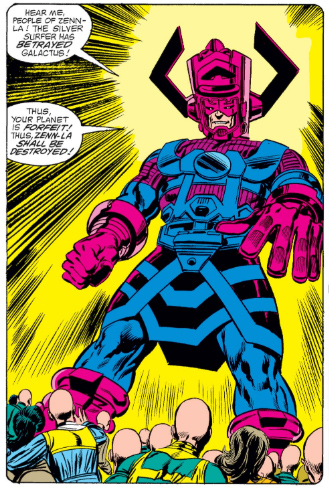 Ever tactful, the surfer goes straight from this tale of planet-wide woe to asking what happened to his girlfriend, Shalla-bal. When he finds out she was kidnapped by Mephisto he flies straight off to find her, leaving behind an entire planet of people whose lives he, at best indirectly, has ruined.
Ever tactful, the surfer goes straight from this tale of planet-wide woe to asking what happened to his girlfriend, Shalla-bal. When he finds out she was kidnapped by Mephisto he flies straight off to find her, leaving behind an entire planet of people whose lives he, at best indirectly, has ruined.
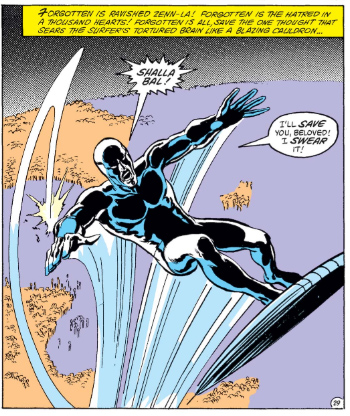 This is where Doctor Doom comes in, with a very brief flashback to the events of Fantastic Four #157 where Doom tricked the Surfer into thinking that he had married Shalla Bal, but then it turned out not to be her, but then - aha! - it turned out that the whole thing was an (over-complicated) scheme by Mephisto to torture all concerned, and it WAS her after all!
This is where Doctor Doom comes in, with a very brief flashback to the events of Fantastic Four #157 where Doom tricked the Surfer into thinking that he had married Shalla Bal, but then it turned out not to be her, but then - aha! - it turned out that the whole thing was an (over-complicated) scheme by Mephisto to torture all concerned, and it WAS her after all!
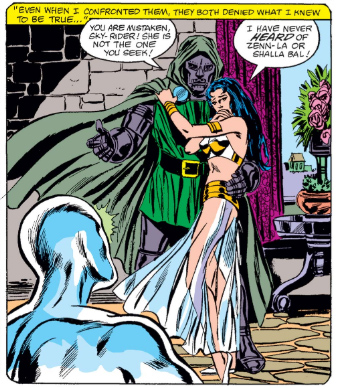 No, I'm not really sure how that's meant to work either. This leads to a Great Dilemma, where the Surfer realises he's got to go back to earth to try and find her, even though this means he will once more be trapped inside the force field, because the thing that Reed Richards did to allow him to escape could only work once. He doesn't spend an awful lot of time considering the matter, which seems a bit daft considering that she might not even be on Earth, and is soon zooming over Doom's castle in Latveria.
No, I'm not really sure how that's meant to work either. This leads to a Great Dilemma, where the Surfer realises he's got to go back to earth to try and find her, even though this means he will once more be trapped inside the force field, because the thing that Reed Richards did to allow him to escape could only work once. He doesn't spend an awful lot of time considering the matter, which seems a bit daft considering that she might not even be on Earth, and is soon zooming over Doom's castle in Latveria.
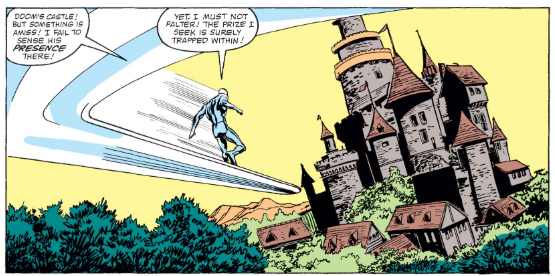 He smashes his way in, duffs up some Doombots, and then finds Shalla Bal (or whoever she is), working in the kitchens. Unsurprisingly, after he's blown up the doors of her place of work for no good reason, she's a bit frightened.
He smashes his way in, duffs up some Doombots, and then finds Shalla Bal (or whoever she is), working in the kitchens. Unsurprisingly, after he's blown up the doors of her place of work for no good reason, she's a bit frightened.
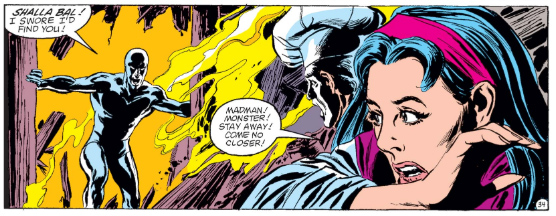 At this point Mephisto shows up and the pair of them have a Big Fight in hell, which ends with Mephisto apparently killing Shalla Bal - because he's the devil, basically, and so not worried about cheating. Mephisto then brings her back to life as an energy form, which he then sends off to Zenn-La again, because this will be an even greater torture for the Surfer, knowing she is still alive but that he can never see her again. I don't know, personally I'd have though just killing her would be worse, but perhaps that's why I don't get to have dominion over Hades?
At this point Mephisto shows up and the pair of them have a Big Fight in hell, which ends with Mephisto apparently killing Shalla Bal - because he's the devil, basically, and so not worried about cheating. Mephisto then brings her back to life as an energy form, which he then sends off to Zenn-La again, because this will be an even greater torture for the Surfer, knowing she is still alive but that he can never see her again. I don't know, personally I'd have though just killing her would be worse, but perhaps that's why I don't get to have dominion over Hades?
The Surfer chases after her but can't catch up. Then he has a great idea - he'll zap her with the Power Cosmic, so that when she does get home she can "undo the horror Mephisto has wrought." By this he means the ruination of the whole planet, which I thought was more his and Galactus's fault rather than Mephisto's, but this does lead to quite a nice ending, with Shalla Bal wandering around with flowers growing wherever she walks.
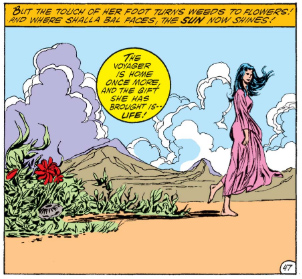 It's a good finish for a fairly daft comic which I think I might have been a bit hard on back in the day. Still, there's no need to worry, as we'll soon back in that much-loved (by me) run of John Byrne's as we start the build-up to Doom's latest return from the dead. However, before we do that, we're going to take some time to look at the results of my Doctor Doom Survey, starting next week!
It's a good finish for a fairly daft comic which I think I might have been a bit hard on back in the day. Still, there's no need to worry, as we'll soon back in that much-loved (by me) run of John Byrne's as we start the build-up to Doom's latest return from the dead. However, before we do that, we're going to take some time to look at the results of my Doctor Doom Survey, starting next week!
posted 30/7/2020 by MJ Hibbett
(click here for permanent link)
(0) comments
What If Iron Man Had Been Trapped In King Arthur's Time?
There's only two pages of Doctor Doom in this story, recapping and slightly changing the one we looked at a little while ago in Iron Man #151. That issue saw Doctor Doom and Iron Man eventually having to work together to escape from King Arthur's time, and this one rather cleverly alters one small aspect to change the entire outcome.
In both versions of the story, Doctor Doom tells Iron Man that they will have to work together to escape. Iron Man asks how he knows he can trust him, and, in the original, Doom replies "Because, Avenger... you have my word."
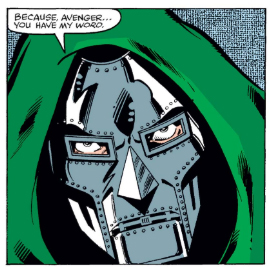 However, in this version of the story he replies instead "Because, Iron Man... you have no choice."
However, in this version of the story he replies instead "Because, Iron Man... you have no choice."
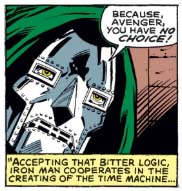 In both cases Tony Stark is forced to accept the offer, and in the mainstream version Doom keeps his word here. However, in the version he has not done so, and is therefore (according to Doom Logic) free to double-cross his colleague and leave him behind. As he disappears he says (a bit meanly I think) "One last bit of advice. Never bargain with an enemy until you first wrest from him his word of honor!"
In both cases Tony Stark is forced to accept the offer, and in the mainstream version Doom keeps his word here. However, in the version he has not done so, and is therefore (according to Doom Logic) free to double-cross his colleague and leave him behind. As he disappears he says (a bit meanly I think) "One last bit of advice. Never bargain with an enemy until you first wrest from him his word of honor!"
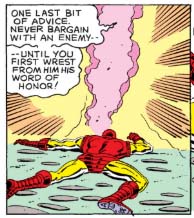 There's no need for that is there? The story then carries on with Iron Man eventually getting voted in as King of England, which I'm pretty sure isn't how it works, but maybe it did then, legendarily, in the Marvel Universe?
There's no need for that is there? The story then carries on with Iron Man eventually getting voted in as King of England, which I'm pretty sure isn't how it works, but maybe it did then, legendarily, in the Marvel Universe?
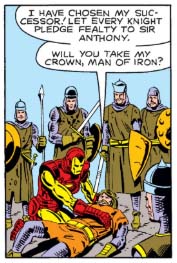 The story ends with The Watcher telling us that "under his leadership, Britain will unite half a world under King Anthony's scepter" which sounds like pretty good going for medieval times, and is a much happier ending than you usually get with "What If?" stories, which always seem to involve a lot of regret and/or mass killings. The artwork throughout also looks pretty nifty, with Bob Layton returning to lay on his usual shiny inks, demonstrating just how much work he does in these situations by making Don Perlin's pencisl disappear almost as much as John Romita's did in the original.
The story ends with The Watcher telling us that "under his leadership, Britain will unite half a world under King Anthony's scepter" which sounds like pretty good going for medieval times, and is a much happier ending than you usually get with "What If?" stories, which always seem to involve a lot of regret and/or mass killings. The artwork throughout also looks pretty nifty, with Bob Layton returning to lay on his usual shiny inks, demonstrating just how much work he does in these situations by making Don Perlin's pencisl disappear almost as much as John Romita's did in the original.
What's most interesting to me here though is the insight into Doom's personality. It's clear that he's entirely happy to betray someone if it's for his own gain, no matter how hard they have worked together, but it's also clear that he would not do so if he had given his word. Both versions of Doom seem correct here, despite them carrying out very different actions.
Next time we're looking at another very tiny appearance, in a comic that I should be a lot more excited about than I actually am!
posted 28/7/2020 by MJ Hibbett
(click here for permanent link)
(0) comments
Everyone's Little In Liddleville!
Doctor Doom doesn't actually appear until halfway through this story, despite the fact that he's central to the cover - and what a great cover it is! Gil Kane is the artist inside the comic as well, and it's amazing to me that a proper comics legend like that should be working on what in theory should be a cheap toy tie-in.
Reading the story, however, it's clear that nobody's told Bill Mantlo and Gil Kane that it's a cheap toy tie-in, as they seem to think it's a key part of the Marvel Universe, free to roam where it wishes, have guest stars, and generally be a thumping good read. I was surprised how enjoyable this was, to be honest, even when the first five pages are about the tiny little Micronauts trying to escape from a stinky sewer.
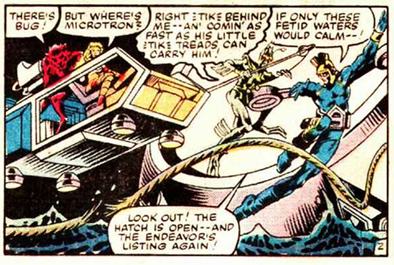 There's then a lengthy sub-plot in the Microverse, where a very Darth Vader/Doctor Doom-ish baddie is laying out the main story arc for the series, and then it's back to the Micronauts themselves. Last issue they visited the Baxter Building, where The Thing told them about their own recent adventure in Liddleville, so the Micronauts head over to Doctor Doom's castle in "the pine-covered slopes of the rolling Adirondak mountains."
There's then a lengthy sub-plot in the Microverse, where a very Darth Vader/Doctor Doom-ish baddie is laying out the main story arc for the series, and then it's back to the Micronauts themselves. Last issue they visited the Baxter Building, where The Thing told them about their own recent adventure in Liddleville, so the Micronauts head over to Doctor Doom's castle in "the pine-covered slopes of the rolling Adirondak mountains."
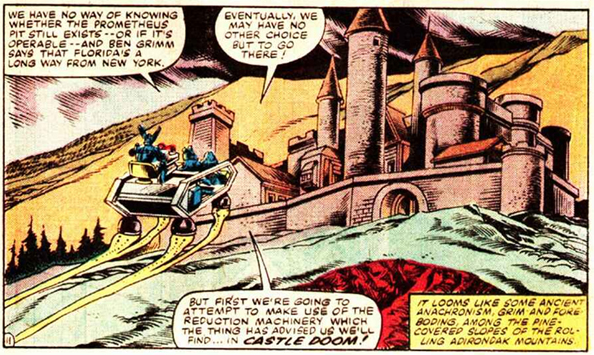 This is a great use of continuity and shows how the Marvel Universe can be flexed to create new stories. If somebody else has done a story about superheroes being turned into the size of action figures, then it only makes sense to follow it up with some superheroes who actually ARE the size of action figures, and see how it all works out from there.
This is a great use of continuity and shows how the Marvel Universe can be flexed to create new stories. If somebody else has done a story about superheroes being turned into the size of action figures, then it only makes sense to follow it up with some superheroes who actually ARE the size of action figures, and see how it all works out from there.
The Micronauts smash their way into Doom's castle, and uncover his piano, as seen when we were last here in Fantastic Four #236.
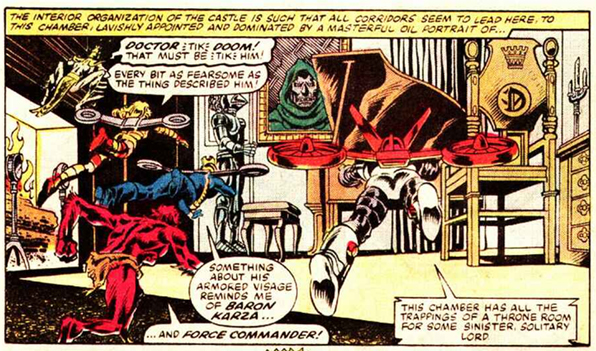
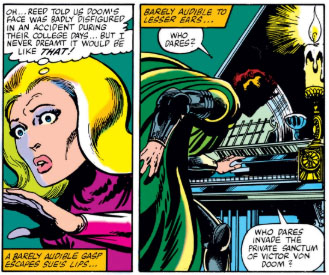 They eventually find Liddleville and land on the outskirts where they meet a tiny citizen who looks remarkably like Tom Baker.
They eventually find Liddleville and land on the outskirts where they meet a tiny citizen who looks remarkably like Tom Baker.
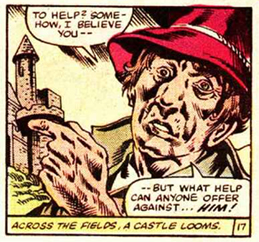 Tom gives them an update on what's happened since we last visited. With Doom out of the way, The Puppet Master became the Mayor of Liddleville, but was overthrown when a fully armoured Doctor Doom returned and took control again. They once again fight their way into Castle Doom, this time a miniature version which Doom has had built, and here they meet Doom himself.
Tom gives them an update on what's happened since we last visited. With Doom out of the way, The Puppet Master became the Mayor of Liddleville, but was overthrown when a fully armoured Doctor Doom returned and took control again. They once again fight their way into Castle Doom, this time a miniature version which Doom has had built, and here they meet Doom himself.
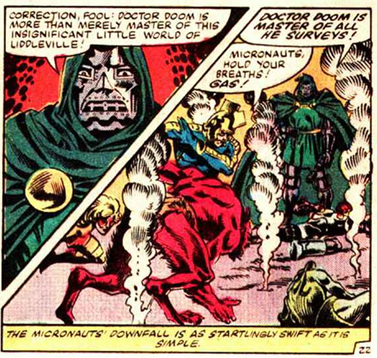 He makes short work of the Micronauts, gassing them and chucking them into the dungeons, where they meet The Puppet Master for another bit of back story about how Liddleville came to be and how Doom managed to come back. The Puppet Master suggests that Doom is enjoying himself in Liddleville because his tiny robot body has a handsome face, rather than his usual scarred visage, which I think is a great bit of characterisation. The Micronauts realise that this is all well and good but won't provide them with a way to return to The Microverse, so when some robot guards turn up they take the opportunity to escape, bashing them to bits and heading for a final confrontation with Doom himself, who they discover playing with his organ.
He makes short work of the Micronauts, gassing them and chucking them into the dungeons, where they meet The Puppet Master for another bit of back story about how Liddleville came to be and how Doom managed to come back. The Puppet Master suggests that Doom is enjoying himself in Liddleville because his tiny robot body has a handsome face, rather than his usual scarred visage, which I think is a great bit of characterisation. The Micronauts realise that this is all well and good but won't provide them with a way to return to The Microverse, so when some robot guards turn up they take the opportunity to escape, bashing them to bits and heading for a final confrontation with Doom himself, who they discover playing with his organ.
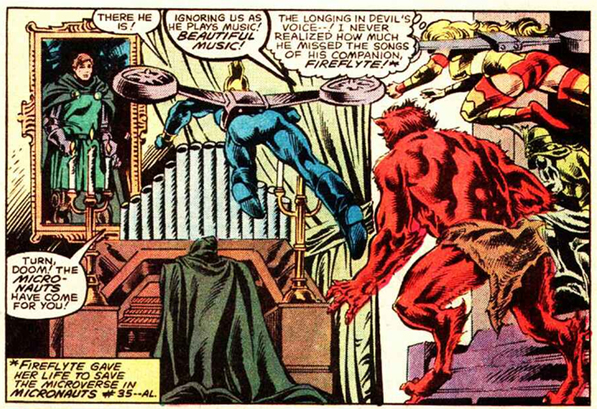 This is a version of the Hyper Sound piano he used against the FF back in Fantastic Four #87.
This is a version of the Hyper Sound piano he used against the FF back in Fantastic Four #87.
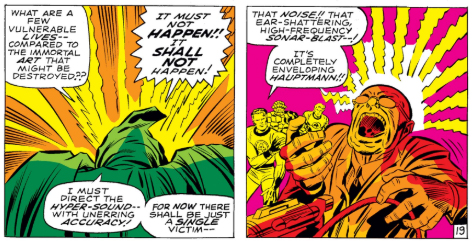 Most of the Micronauts are knocked down, apart from Acroyear who is strong enough to smash the piano to bits with his sword. It's a great bit of comicbook action which is immediately followed up with some more as he and Doom launch into a sword fight.
Most of the Micronauts are knocked down, apart from Acroyear who is strong enough to smash the piano to bits with his sword. It's a great bit of comicbook action which is immediately followed up with some more as he and Doom launch into a sword fight.
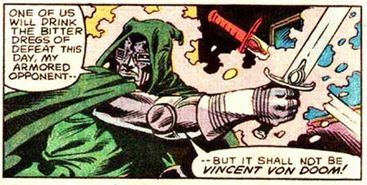 Doom ends up fighting the whole team, and is only beaten when he realises that Acroyear's flaming sword has set the room on fire, and his painting and other works of art are burning. The whole thing reminds Doom of his own accident years ago.
Doom ends up fighting the whole team, and is only beaten when he realises that Acroyear's flaming sword has set the room on fire, and his painting and other works of art are burning. The whole thing reminds Doom of his own accident years ago.
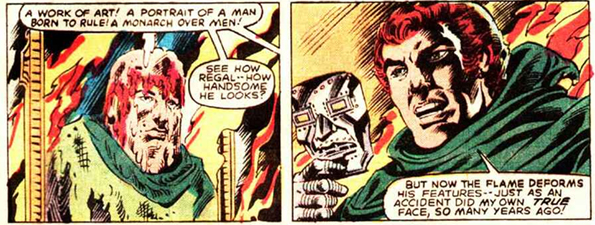 It's great stuff, only slightly spoiled by The Puppet Master turning up to reveal that he still had some Radioactive Clay left, and so has managed to use it to trap Doom where he is. It all feels a bit like Bill Mantlo suddenly remembered that he'd got to the last page, especially as it leads to the Micronauts getting straight into their flying ship and zooming off for the next issue, but it does lead to a fantastic face-off between the two villains, as Doom's handsome face literally melts off while he swears revenge.
It's great stuff, only slightly spoiled by The Puppet Master turning up to reveal that he still had some Radioactive Clay left, and so has managed to use it to trap Doom where he is. It all feels a bit like Bill Mantlo suddenly remembered that he'd got to the last page, especially as it leads to the Micronauts getting straight into their flying ship and zooming off for the next issue, but it does lead to a fantastic face-off between the two villains, as Doom's handsome face literally melts off while he swears revenge.
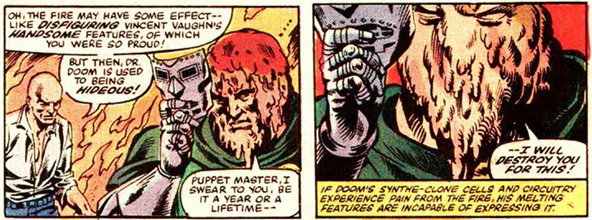 It's a great ending which deserves to be followed up, and it will be pretty soon when John Byrne uses it as the starting point for a whole new story, but before then we've got a bunch of cameos, re-caps and, next time, What Ifs?
It's a great ending which deserves to be followed up, and it will be pretty soon when John Byrne uses it as the starting point for a whole new story, but before then we've got a bunch of cameos, re-caps and, next time, What Ifs?
posted 24/7/2020 by MJ Hibbett
(click here for permanent link)
(0) comments
When Titans Chuckle!
That sound you hear is me whooping and hollering with glee, because today we're going to be looking at my absolute most favourite type of comic - a Marvel "humour" magazine!
That sarcasm, and those quotation marks, are used advisedly, as there is rarely anything remotely funny about these comics, and "Fantastic Four Roast" is no different. It's a special written and pencilled by Fred Hembeck, who I seem to remember being Marvel's go-to person for this sort of thing in the early 1980s, including a regular strip in "Marvel Age". It's a very gentle sort of comedy that at the time made me oddly grumpy, as it always felt like he was the company jester, making acceptable mockery while still toeing the company line, especially when it came to Jim Shooter. I imagined him as a fanzine guy who had taken the corporate shilling, which was pretty rich coming from me, someone very happy to give that corporation his dinner money every week!
Reading it back now however, I can see there's a definite charm too it, even if it's still not particularly funny, although I may have been swayed slightly by seeing the cover of one of his earlier comics, below!
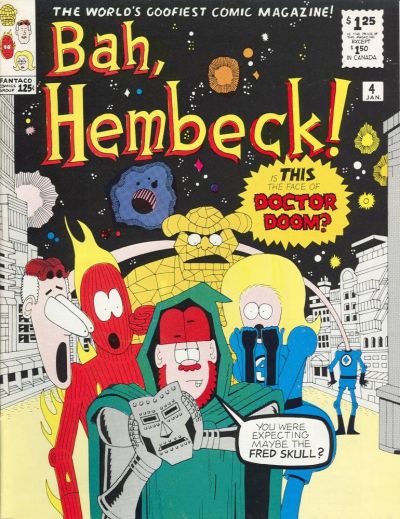 The story here is that the Fantastic Four think they're attending a special dinner where their achievements will be toasted but, when they arrive, the host Fred Hembeck tells them it's actually a "roast", where their peers will come on and mock them. When I bought this comics, back in 1982, this was an entirely alien concept to me, and though these days I've seen a few roasts on telly I have to say it still feels like a weird thing to do - why would you want to watch a famous comedian (it's usually a comedian) pretend to enjoy their contemporaries being unfunnily mean about them?
The story here is that the Fantastic Four think they're attending a special dinner where their achievements will be toasted but, when they arrive, the host Fred Hembeck tells them it's actually a "roast", where their peers will come on and mock them. When I bought this comics, back in 1982, this was an entirely alien concept to me, and though these days I've seen a few roasts on telly I have to say it still feels like a weird thing to do - why would you want to watch a famous comedian (it's usually a comedian) pretend to enjoy their contemporaries being unfunnily mean about them?
Clearly this comic still has the power to make me feel grumpy! One thing I did enjoy about re-reading it though was the artists' jam, whereby each page has a different character roasting the FF, with Hembeck's pencils inked by the creators most closely linked with them at that time. This means you get Mike Zeck on Captain America, Bob Layton on Iron Man, Sal Buscema on the Hulk, and even Frank Miller on Daredevil!
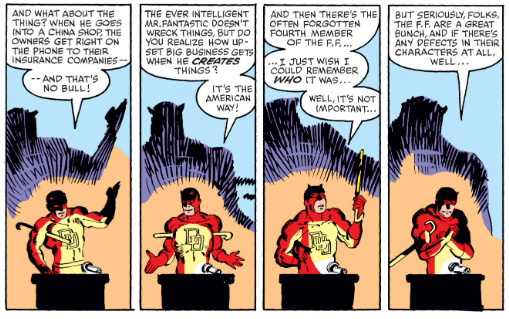 These pages do feel a lot like Not Brand Echh and other Marvel attempts at humour, with slightly exaggerated figures, lots of dialogue, and panels packed with pretty lame jokes.
These pages do feel a lot like Not Brand Echh and other Marvel attempts at humour, with slightly exaggerated figures, lots of dialogue, and panels packed with pretty lame jokes.
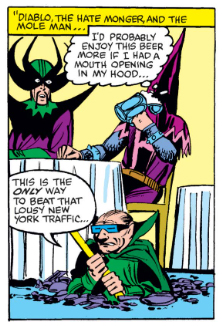 It even manages to squeeze in that old standby for hilarity, Aunt May as a superhero!
It even manages to squeeze in that old standby for hilarity, Aunt May as a superhero!
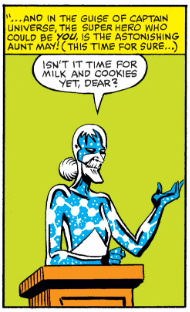 As the story progresses we learn that someone is trying to sabotage the meal and, of course, the main suspect is Doctor Doom. When the Thing mentions this Doom himself appears to say how unfair it is that he always gets the blame.
As the story progresses we learn that someone is trying to sabotage the meal and, of course, the main suspect is Doctor Doom. When the Thing mentions this Doom himself appears to say how unfair it is that he always gets the blame.
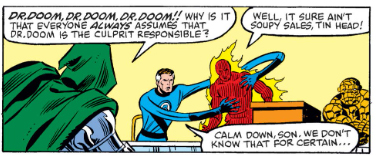 This leads into a rant which re-evaluates his origin as the result of Reed Richards and other students not inviting him on a "panty raid" back in college, which made him too upset to check his own calculations and thus causing the accident which scarred him.
This leads into a rant which re-evaluates his origin as the result of Reed Richards and other students not inviting him on a "panty raid" back in college, which made him too upset to check his own calculations and thus causing the accident which scarred him.
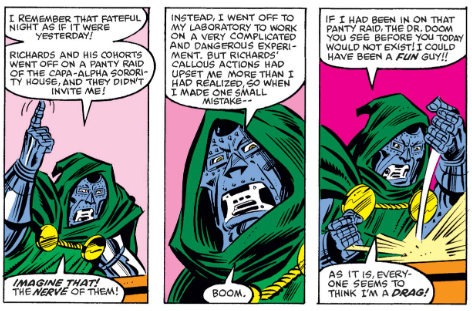 This is definitely a re-writing of the origin, but I think it's safe to say it's not one that was ever taken up by other creators. Doom doesn't appear again, and the issue continues with the villian being revealed to be the FF's mailman Willie Lumpkin, who accidentally fell into one of Reed Richard's inventions. It is distinctly silly from start to finish, something which Hembeck talks about in the inside page, making a claim for this being part of a long legacy of silliness in the Fantastic Four.
This is definitely a re-writing of the origin, but I think it's safe to say it's not one that was ever taken up by other creators. Doom doesn't appear again, and the issue continues with the villian being revealed to be the FF's mailman Willie Lumpkin, who accidentally fell into one of Reed Richard's inventions. It is distinctly silly from start to finish, something which Hembeck talks about in the inside page, making a claim for this being part of a long legacy of silliness in the Fantastic Four.
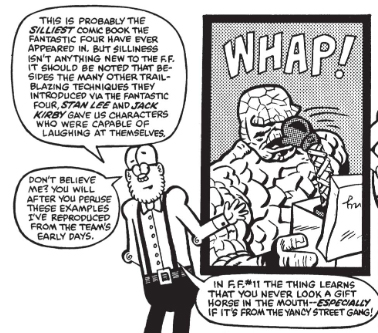 It's a nicely argued point with some very silly examples, which is part of the reason why this is my favourite page in the book. However, the main reason it's my favourite is that it's also the last page in the book!
It's a nicely argued point with some very silly examples, which is part of the reason why this is my favourite page in the book. However, the main reason it's my favourite is that it's also the last page in the book!
Next time we're back to the deadly serious world of the Marvel Universe proper, as we delve into the deadly serious adventures of The Micronauts!
posted 17/7/2020 by MJ Hibbett
(click here for permanent link)
(0) comments
Doctor Doom and the Flying Saucer
This time we're looking at a story that appeared in the "Amazing Spider-man" newspaper strip from December 7 1981 through to March 21 1982. It sounds like a lot to get through, but the nature of these strips means that the story takes an awfully long time to tell. The daily strips are at most three panels each, and these are usually a recap, a single panel of actual plot, and then a cliffhanger or joke ending, while the double-length colour sunday strips are generally designed not to carry very much story, so that readers of newspapers that didn't have a sunday edition wouldn't miss out. All in all, this means you get the equivalent of about two comics pages of story a week!
The first week sees the world reeling from the news that Doctor Doom has, apparently, captured a flying saucer. This is not the same Marvel Universe as the one in the comics, where aliens and UFOs are everyday occurrences. Here, nobody has ever seen a real UFO, and so it's big news, including at our favourite Doom location, the United Nations.
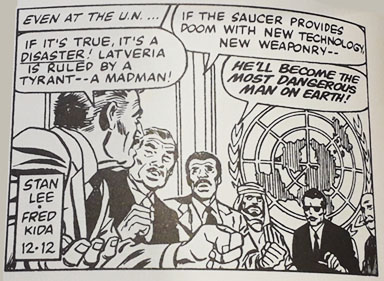 (apologies for the blurry/wonky pictures in this blog - most of them come from my own collected version of these strips, taken on my phone!)
(apologies for the blurry/wonky pictures in this blog - most of them come from my own collected version of these strips, taken on my phone!)
The nezt week of strips sees Peter Parker flying off to Latveria as the photographer for top investigative reporter Kitty Howell. When they arrive at the border they find the rest of the world's media stuck outside, unable to get in. Luckily for Peter and Kitty, however, Doctor Doom is watching as usual, and takes a shine to the reporter.
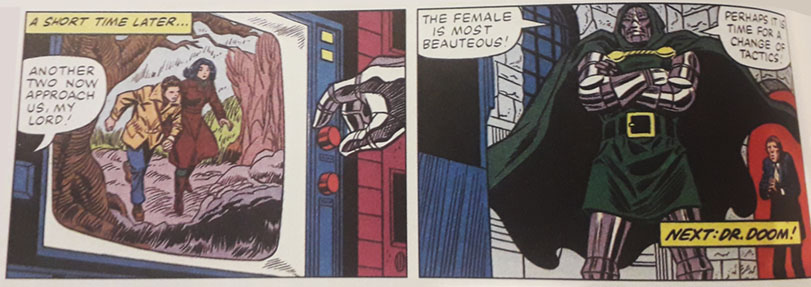 The gates open to allow the team from the Bugle inside, where Doom greets them and explains that the UFO crashed after hitting the "protective lasser screen that makes Latveria the most impregnable nation on Earth!" He takes them on a tour of his castle before (finally, after two weeks of this!) showing them the UFO through a glass screen. Kitty asks when they can get inside for a proper look, and Doom replies "Never!"
The gates open to allow the team from the Bugle inside, where Doom greets them and explains that the UFO crashed after hitting the "protective lasser screen that makes Latveria the most impregnable nation on Earth!" He takes them on a tour of his castle before (finally, after two weeks of this!) showing them the UFO through a glass screen. Kitty asks when they can get inside for a proper look, and Doom replies "Never!"
Something shifty is clearly going on, so once he and Kitty have been sent to their rooms for the night, Peter puts on his Spidey costume and goes off to investigate. While he does so we get a great image of Doctor Doom sitting at his bank of computers.
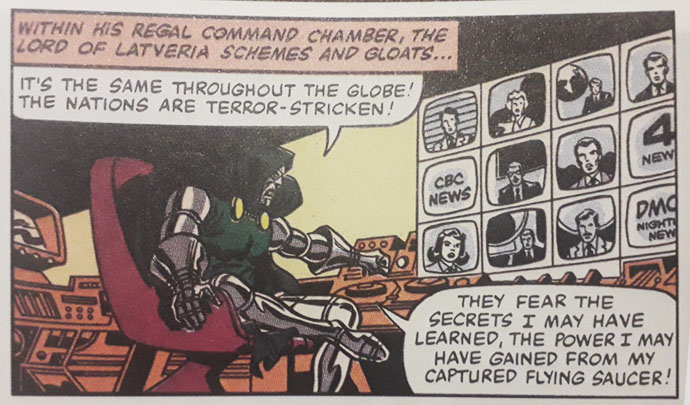 Not only does the purple chair and console behind him echo the control centres we've seen in the comics and the recent cartoons, but the bank of screens is almost a foretelling of Ozymandias's control centre in Watchmen. SPOILERS: this is not the only, or the biggest, such foretelling!
Not only does the purple chair and console behind him echo the control centres we've seen in the comics and the recent cartoons, but the bank of screens is almost a foretelling of Ozymandias's control centre in Watchmen. SPOILERS: this is not the only, or the biggest, such foretelling!
Spidey spends the next week avoiding Doom's guards, until he eventually finds a hiding place in... a movie studio?
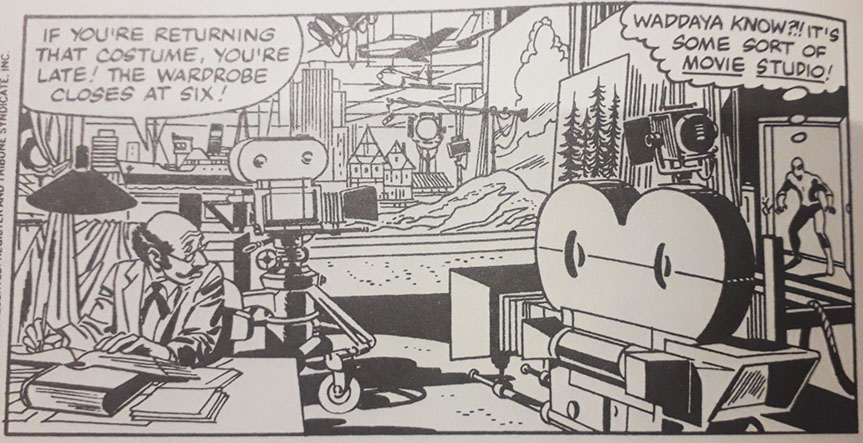 The next morning, over breakfast, Doom goes on an extended rant about the iniquities of American justice which, he says, favours the criminal over the victim. In America, he says, law-abiding citizens live in fear, while in Latveria they are safe from harm. It's a point that will be repeated in a year or two when the FF visit Latveria during John Byrne's run.
The next morning, over breakfast, Doom goes on an extended rant about the iniquities of American justice which, he says, favours the criminal over the victim. In America, he says, law-abiding citizens live in fear, while in Latveria they are safe from harm. It's a point that will be repeated in a year or two when the FF visit Latveria during John Byrne's run.
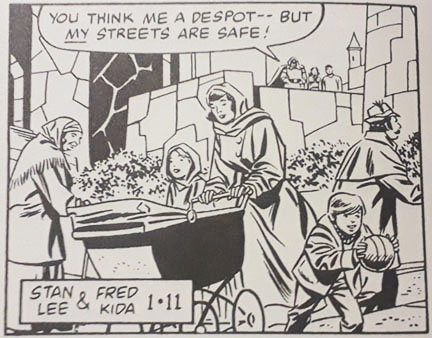 Finally, nearly six weeks into the story, Peter and Kitty get to see the space ship close-up, but they're still not allowed inside. Frustrated by this behaviour Kitty asks Peter why Doom is the way he is and this, rather excitingly, leads us into a very interesting retelling of Doom's origin. Regular visitors here will know that I recently undertook a survey to find out what people thought were Doom's core characteristics - I'll be doing a blog post about the results soon, but one of the main things to come out of it was that Doom's hatred of Reed Richards was seen to be one of the most important aspects of who he is. And yet, in the newspaper strip, Reed Richards does not appear at all!
Finally, nearly six weeks into the story, Peter and Kitty get to see the space ship close-up, but they're still not allowed inside. Frustrated by this behaviour Kitty asks Peter why Doom is the way he is and this, rather excitingly, leads us into a very interesting retelling of Doom's origin. Regular visitors here will know that I recently undertook a survey to find out what people thought were Doom's core characteristics - I'll be doing a blog post about the results soon, but one of the main things to come out of it was that Doom's hatred of Reed Richards was seen to be one of the most important aspects of who he is. And yet, in the newspaper strip, Reed Richards does not appear at all!
This version of the origin story starts much as it does in the comics. Doom's father is called to save the Baron's wife, and they are forced to flee when she dies. His father then dies from exposure and young Victor is rescued by Boris, then later he discovers his mother's "forbidden charms" and "magical symbols" while searching through a chest that looks a lot like the scene we have previously seen in comics.
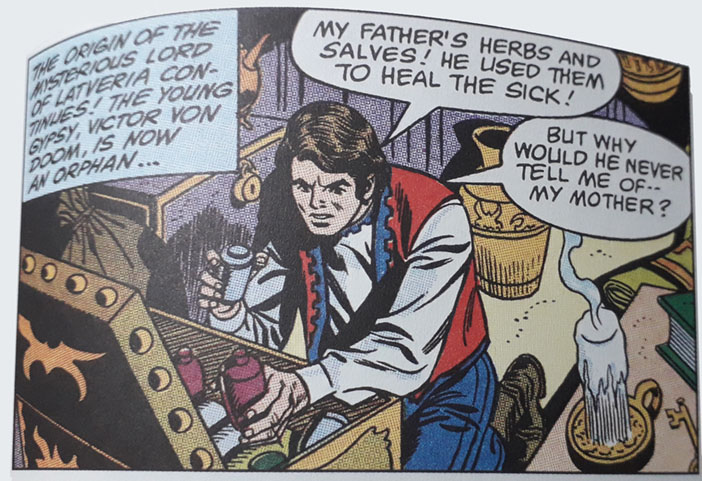
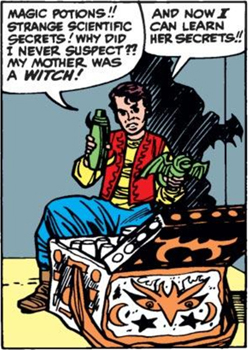 However, after that we suddenly leap forward ten years, missing out his time as a trickster in Latveria and any hint of attending college in America, to find a "tormented youth" living the high life, who has used these gifts to make money.
However, after that we suddenly leap forward ten years, missing out his time as a trickster in Latveria and any hint of attending college in America, to find a "tormented youth" living the high life, who has used these gifts to make money.
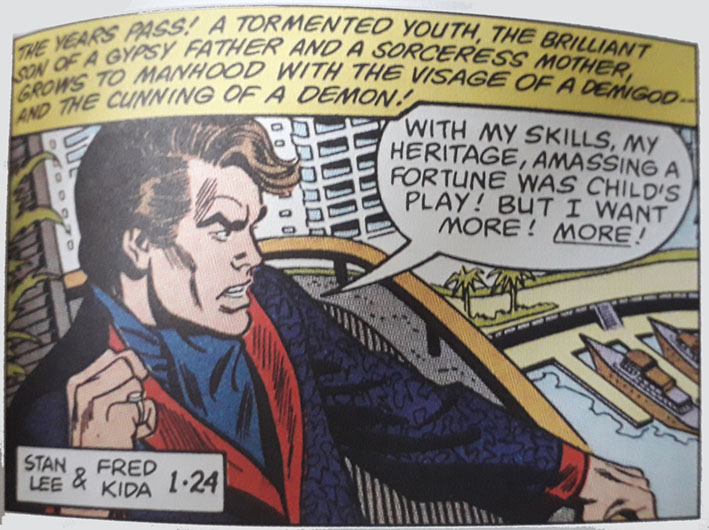 He decides to seek revenge on those who have wronged him, but while conducting "his most dangerous experiment" (which doesn't seem to be linked to any form of revenge) there's an explosion which destroys his face. Things then continue as normal, with the trip to Tibet, the monks, the armour and mask, and finally the declaration of his new identity.
He decides to seek revenge on those who have wronged him, but while conducting "his most dangerous experiment" (which doesn't seem to be linked to any form of revenge) there's an explosion which destroys his face. Things then continue as normal, with the trip to Tibet, the monks, the armour and mask, and finally the declaration of his new identity.
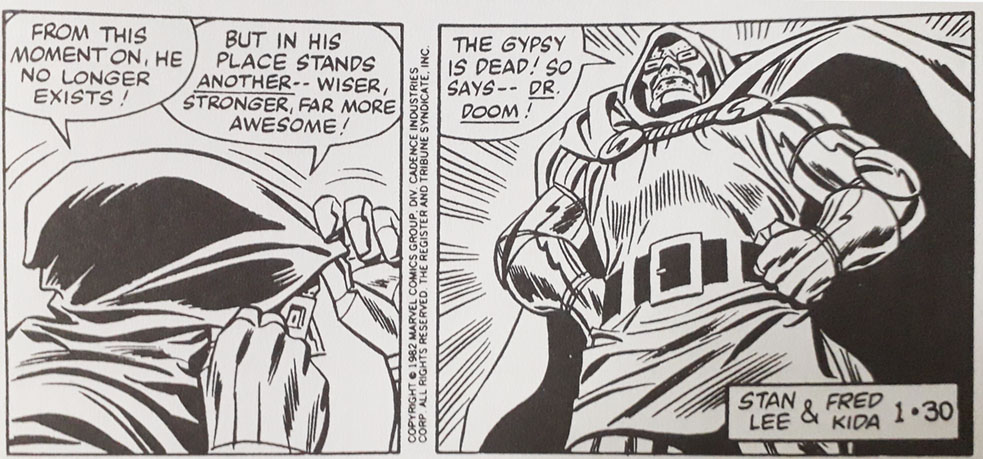 We then get an extra slice of origin which has not yet been seen in the comics, as Doom returns to Latveria and, with the Baron now dead, is able to take control of the country. All in a single panel!
We then get an extra slice of origin which has not yet been seen in the comics, as Doom returns to Latveria and, with the Baron now dead, is able to take control of the country. All in a single panel!
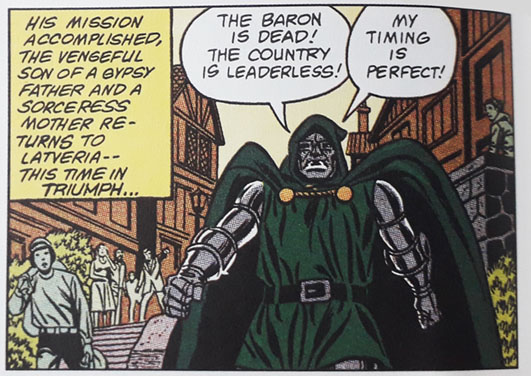 This is a fascinating version of the origin, because it contains everything necessary for Doom to work as a Spider-man villain, and indeed a character in his own right (including the often omitted explanation of how he came to power), without needing to link it to the Fantastic Four. And it works! This is very clearly Doctor Doom, albeit one motivated entirely by his desire for revenge on the world for the murder of his parents, rather than throwing in an obsession with Reed Richards as well. Even in the recent cartoon version of his origin the accident happens at college, with someone who looks a lot like Reed Richards, so this is the most radical revision to his origin since... well, Spidey Super Stories!
This is a fascinating version of the origin, because it contains everything necessary for Doom to work as a Spider-man villain, and indeed a character in his own right (including the often omitted explanation of how he came to power), without needing to link it to the Fantastic Four. And it works! This is very clearly Doctor Doom, albeit one motivated entirely by his desire for revenge on the world for the murder of his parents, rather than throwing in an obsession with Reed Richards as well. Even in the recent cartoon version of his origin the accident happens at college, with someone who looks a lot like Reed Richards, so this is the most radical revision to his origin since... well, Spidey Super Stories!
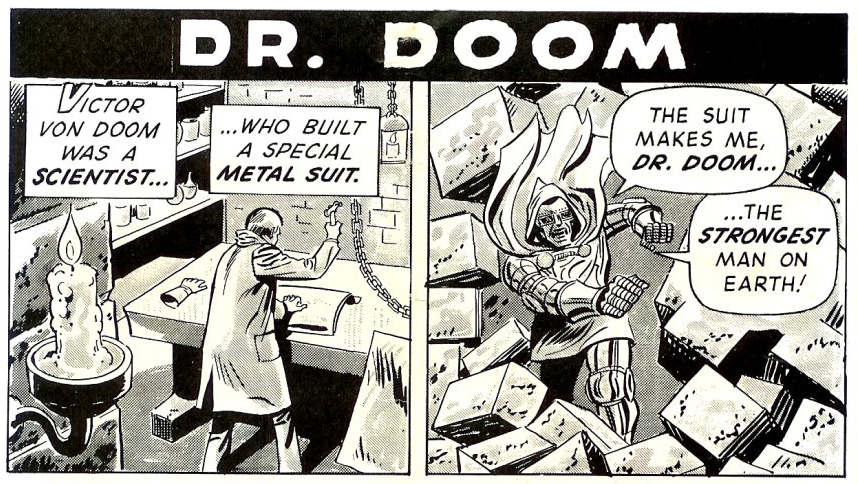 With all that sorted out the story continues with Doom threatening the world with an "omega ray", which he has derived from the technology in the flying saucer. There then follows several weeks of to-ing and fro-ing while the world trembles in fear of what this weapon might do, and Spider-man tries to get inside the saucer to see what's going on. Finally, in late February, he finally gets inside and learns... the secret!
With all that sorted out the story continues with Doom threatening the world with an "omega ray", which he has derived from the technology in the flying saucer. There then follows several weeks of to-ing and fro-ing while the world trembles in fear of what this weapon might do, and Spider-man tries to get inside the saucer to see what's going on. Finally, in late February, he finally gets inside and learns... the secret!
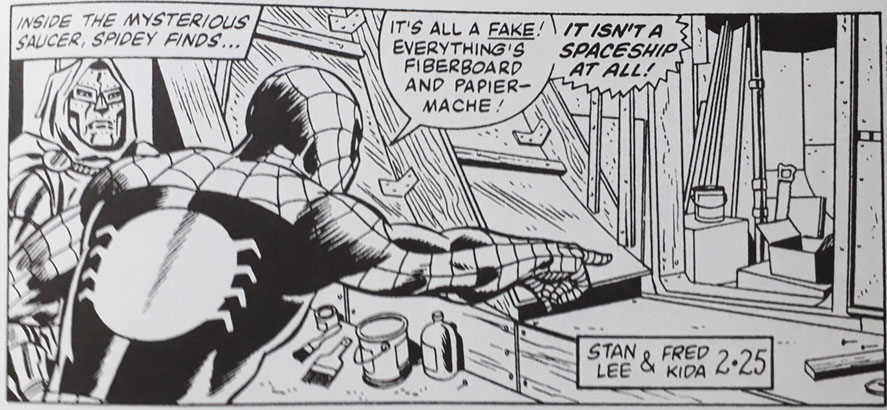 I love the fact that the lackeys who built the prop spaceship never got around to tidying up when they were finished... or maybe Doom had them killed? Anyway, Doom captures Spidey and chucks him in the dungeon, which he immediately escapes from. There's then several weeks of business with Doom's guards chasing Spider-man until eventually the tables are turned and Spidey captures Doom in a massive web. However, when Doom agrees to talk, Spidey lets him go, trusting to his famous sense of honour.
I love the fact that the lackeys who built the prop spaceship never got around to tidying up when they were finished... or maybe Doom had them killed? Anyway, Doom captures Spidey and chucks him in the dungeon, which he immediately escapes from. There's then several weeks of business with Doom's guards chasing Spider-man until eventually the tables are turned and Spidey captures Doom in a massive web. However, when Doom agrees to talk, Spidey lets him go, trusting to his famous sense of honour.
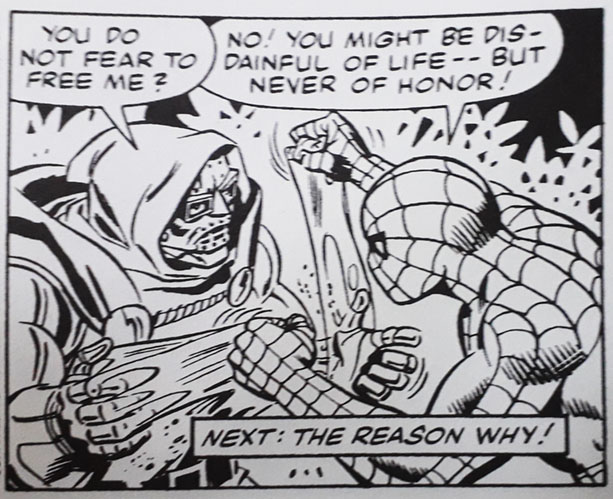 Finally the scheme is revealed - Doom "planned a bloodless coup!" in which he would "bring order to the world, without a shot being fired." "All I wanted was to bring peace to the world" he says, to which Spidey replies:
Finally the scheme is revealed - Doom "planned a bloodless coup!" in which he would "bring order to the world, without a shot being fired." "All I wanted was to bring peace to the world" he says, to which Spidey replies:
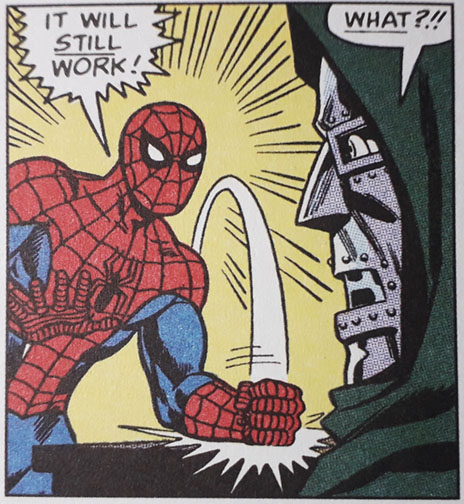 Doom agrees to Spidey's plan (which is not yet revealed to the reader), and Peter Parker returns to the USA with a special film by Doctor Doom, where he claims that the aliens have now left the planet, leaving behind them a deadly warning.
Doom agrees to Spidey's plan (which is not yet revealed to the reader), and Peter Parker returns to the USA with a special film by Doctor Doom, where he claims that the aliens have now left the planet, leaving behind them a deadly warning.
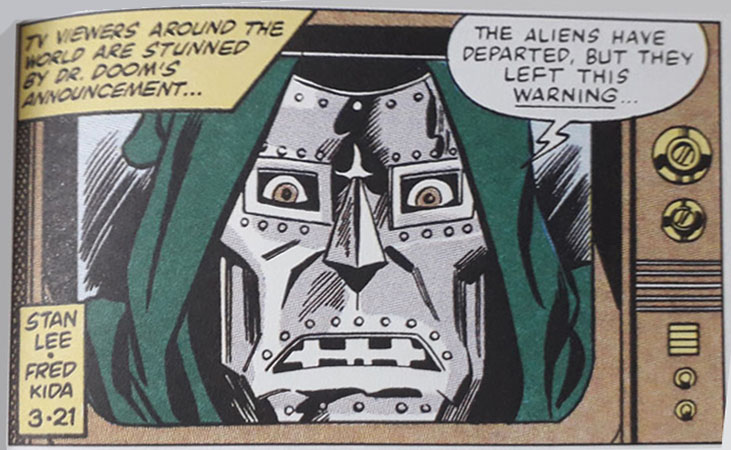
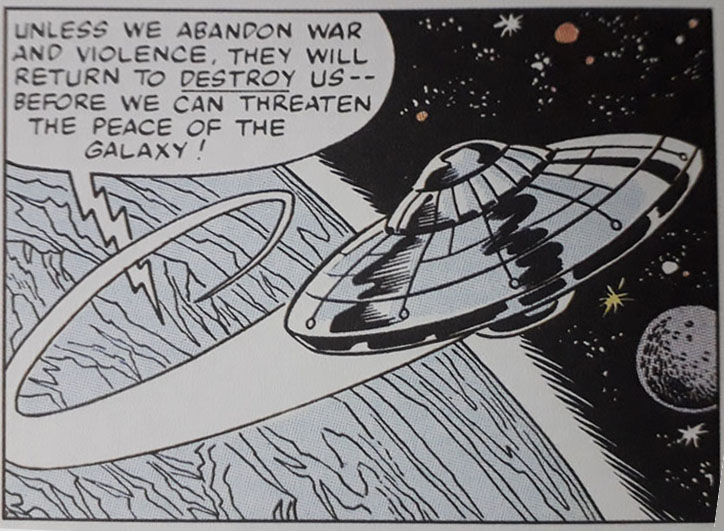 Interestingly, the image used here is very similar to that used in Astonishing Tales #4, where Doom was once again appearing on screen, giving commands.
Interestingly, the image used here is very similar to that used in Astonishing Tales #4, where Doom was once again appearing on screen, giving commands.
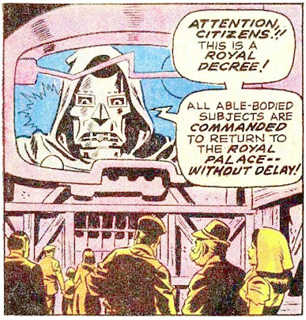 And that's pretty much where the story ends, with just time for another visit to The United Nations.
And that's pretty much where the story ends, with just time for another visit to The United Nations.
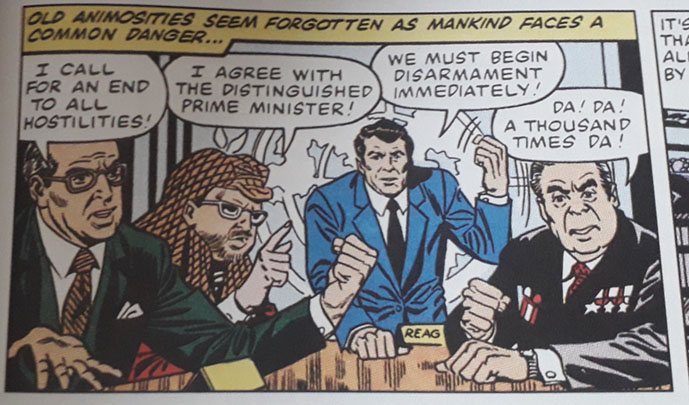 All it needs is for somoene to find Peter Parker's notes on what really happened, maybe in a slush pile at the Daily Bugle offices...
All it needs is for somoene to find Peter Parker's notes on what really happened, maybe in a slush pile at the Daily Bugle offices...
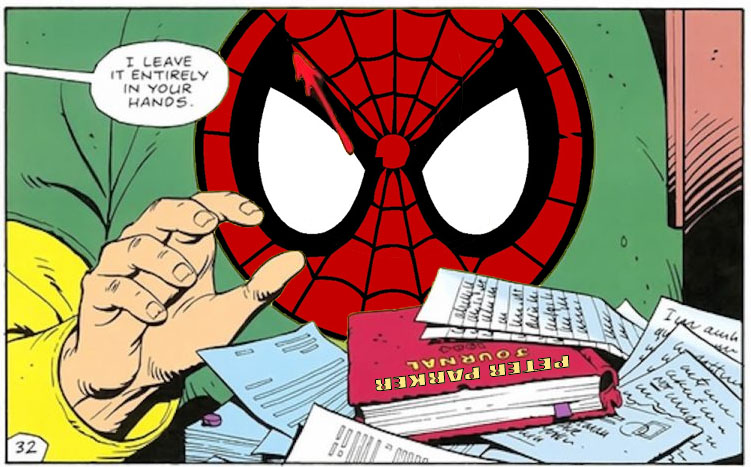 Quite apart from how strange it is to see that much-discussed story pre-empted in a little mentioned newspaper strip, this has been a fascinating look at a Doctor Doom who has displayed all his usual traits of arrogance, honour, and megalomania, all without the need of one apparently vital aspect of his origin. You can bet I'll be discussing this in my thesis!
Quite apart from how strange it is to see that much-discussed story pre-empted in a little mentioned newspaper strip, this has been a fascinating look at a Doctor Doom who has displayed all his usual traits of arrogance, honour, and megalomania, all without the need of one apparently vital aspect of his origin. You can bet I'll be discussing this in my thesis!
posted 10/7/2020 by MJ Hibbett
(click here for permanent link)
(1) comments
The Lady IS For Burning
We're now into the realm of Issues Of Fantastic Four I Actually Own, and I distinctly remember reading this comic when it first came out, having my mind blown by THREE incredible stories. The main story, as promised on the cover gives us "the startling secret of Frankie Raye" (she's the adopted daughter of the inventor of the original Human Torch, and as a result got given flame powers as a child), while the final story featues "a dramatic development in the life of The Thing". It was the middle story I remember the most though, not for this issue but the next one when it turns out that the woman introduced here is actually Ben Grimm's much-mentioned but never seen Aunt Petunia!
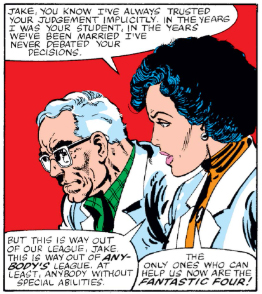 There is, however, no Doctor Doom inside, just as it says on the cover. It's a great cover, and an image that has been repurposed many times (including by me!), but I couldn't find any explanation online as to why such an unusual image was used. Luckily though, as I say, this is a run of comics that I actually own, so I was able to check the corresponding letters page a few months later in issue #243, where I discovered a reader complaining about John Byrne's egomania in putting himself on the cover. In reply, the editor Jim Salicrup reveals that it was his idea, and that he actually came up with the cover concept himself, after Byrne had told him that there were no actual villains in the issue at all.
There is, however, no Doctor Doom inside, just as it says on the cover. It's a great cover, and an image that has been repurposed many times (including by me!), but I couldn't find any explanation online as to why such an unusual image was used. Luckily though, as I say, this is a run of comics that I actually own, so I was able to check the corresponding letters page a few months later in issue #243, where I discovered a reader complaining about John Byrne's egomania in putting himself on the cover. In reply, the editor Jim Salicrup reveals that it was his idea, and that he actually came up with the cover concept himself, after Byrne had told him that there were no actual villains in the issue at all.
As I've said before, I love this run and often wished for an issue where nothing much happened, and we just follow the characters through their daily life. I never realised I got so close to what I was after with this very issue - it's even referenced at the start of the final story!
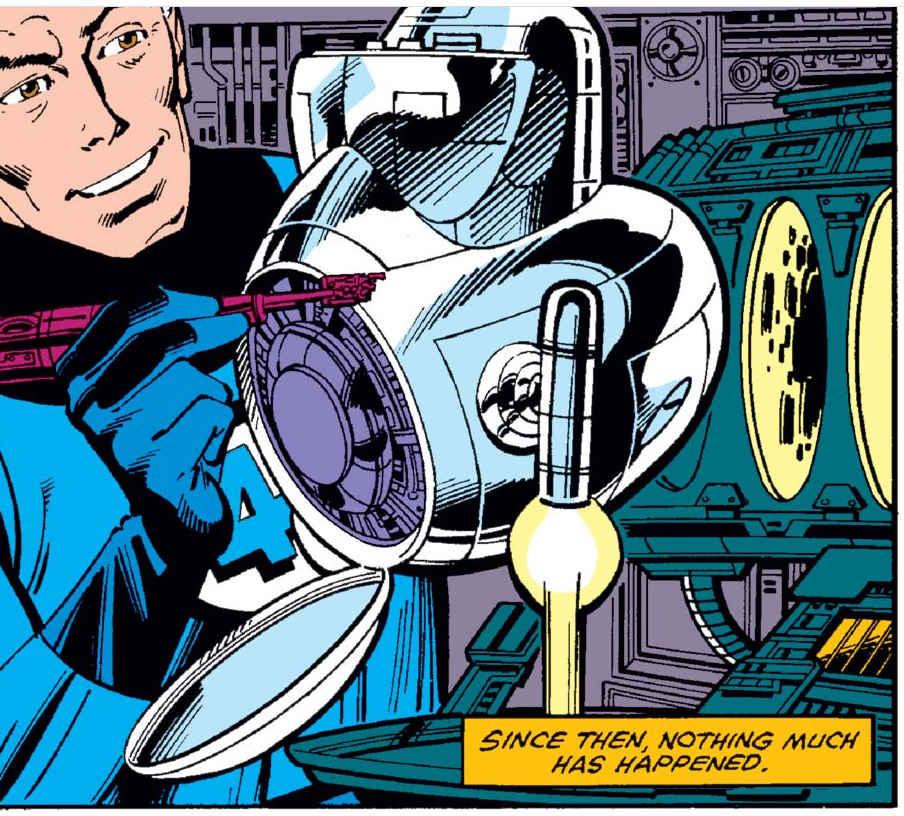 Next time there will be a lot more Doom, and definitely a lot more happening, as we return to the Spider-man newspaper strip for a nefarious scheme that uses a plot point from Watchmen several years before Watchmen ever did!
Next time there will be a lot more Doom, and definitely a lot more happening, as we return to the Spider-man newspaper strip for a nefarious scheme that uses a plot point from Watchmen several years before Watchmen ever did!
posted 8/7/2020 by MJ Hibbett
(click here for permanent link)
(0) comments
The Colorado Caper
It is my sad duty to inform you that today's blog concerns a comic that I have not actually read.
This has happened before - not long ago we looked at Fun And Games Magazine which had Doom on the cover - but that didn't feel so bad as it wasn't really a narrative comic as such. This very much is, as explained in this rather lovely description of the contents in the independent voice for Denver since 1977.
"The Colorado Caper" was a special advertising promotion given away free with The Denver Post to promote a local department store, in which Spider-man and the Hulk appeared in advertisements for the shop interspersed into a full-length comics story, which saw Doctor Doom kidnapping a scientist's daughter. Hulk and Spidey team up with a local reporter to foil the plot, and it all ends with a celebratory trip to the local shops!
It all sounds very interesting, not least because it sort of links to an article I've been writing about Doctor Doom's Milk Duds ad and other uses of superheroes in advertising. Sadly, all I could find online were the following very small, very partial scans.
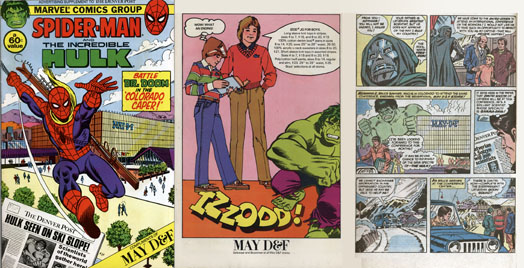
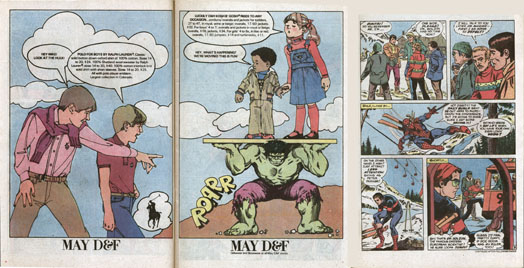 If anyone out there has access to this comic I'd love to get a look at it, but for now we'll carry on next time with a comic which makes the entire cover about the "fact" that Doctor Doom does not appear in it!
If anyone out there has access to this comic I'd love to get a look at it, but for now we'll carry on next time with a comic which makes the entire cover about the "fact" that Doctor Doom does not appear in it!
posted 2/7/2020 by MJ Hibbett
(click here for permanent link)
(1) comments